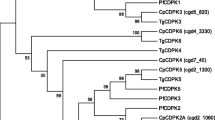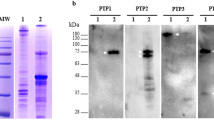Abstract
Chaperonin 60 (Cpn60) is a well-established marker protein for eukaryotic mitochondria and plastids. In order to determine whether the small double-membrane-bounded organelle posterior to the nucleus in the apicomplexan Cryptosporidium parvum is a mitochondrion, the Cpn60 gene of C. parvum sporozoites (CpCpn60) was analyzed and antibodies were generated for localization of the peptide. Sequence and phylogenetic analyses indicated that CpCpn60 is a mitochondrial isotype and that antibodies against it localize to the rough endoplasmic reticulum-enveloped remnant organelle of C. parvum sporozoites. These data show this organelle is of mitochondrial origin.






Similar content being viewed by others
References
Adachi J, Hasegawa M (1996) Model of amino acid substitution in proteins encoded by mitochondrial DNA. J Mol Evol 42:459–468
Aji T, Flanigan T, Marshall R, Kaetzel C, Aikawa M (1991) Ultrastructural study of asexual development of Cryptosporidium parvum in a human intestinal cell line. J Protozool 38:82S
Archibald JM, Logsdon JM Jr, Doolittle WF (2000) Origin and evolution of eukaryotic chaperonins: phylogenetic evidence for ancient duplications in CCT genes. Mol Biol Evol 17:1456–1466
Archibald JM, O′Kelly CJ, Doolittle WF (2002) The chaperonin genes of jakobid and jakobid-like flagellates: implications for eukaryotic evolution. Mol Biol Evol 2002:422–431
Barta JR (1989) Phylogenetic analysis of the class Sporozoea (phylum Apicomplexa Levine, 1970): evidence for the independent evolution of heteroxenous life cycles. J Parasitol 75:195–206
Braig K, et al (1994) The crystal structure of the bacterial chaperonin GroEL at 2.8 A. Nature 371:578–586
Brocchieri L, Karlin S (2000) Conservation among HSP60 sequences in relation to structure, function, and evolution. Protein Sci 9:476–486
Bui ET, Bradley PJ, Johnson PJ (1996) A common evolutionary origin for mitochondria and hydrogenosomes. Proc Natl Acad Sci USA 18:9651–9616
Carreno RA, Martin DS, Barta JR (1999) Cryptosporidium is more closely related to the gregarines than to coccidia as shown by phylogenetic analysis of apiocomplexan parasites inferred using small-subunit ribosomal RNA gene sequences. Parasitol Res 85:899–904
Cavalier-Smith T (1983) A 6 kingdom classification and a unified phylogeny. In: Schwemmler W, Schenk HEA (eds) Endocytobiology II. De Gruyter, Berlin, pp 1027–1034
Clark CG, Roger AJ (1995) Direct evidence for secondary loss of mitochondria in Entamoeba histolytica. Proc Natl Acad Sci USA 92:6518–6521
Claros MG, Vincens P (1996) Computational method to predict mitochondrially imported proteins and their targeting sequences. Eur J Biochem 241:779–786
Crawford MJ, Fraunholz MJ, Roos DS (2003) Energy metabolism in the Apicomplexa. In: Marr JJ, Nilsen TW, Komuniecki RW (eds) Molecular medical parasitology. Academic Press, New York, pp 154–169
Crowley KS, Payne RM (1998) Ribosome binding to mitochondria is regulated by GTP and the transit peptide. J Biol Chem 273:17278–17285
Das A, Syin C, Fujioka H, Zheng H, Goldman N, Aikawa M, Kumar N (1997) Molecular characterization and ultrastructural localization of Plasmodium falciparum Hsp60. Mol Biochem Parasitol 88:95–104
Ellis TJ, Morrison DA, Jeffries AC (1998) The phylum Apicomplexa: an update on the molecular phylogeny. In: Coombs GH, Vickerman K, Sleigh MA, Warren A (eds) Evolutionary relationships among Protozoa. Kluwer, Boston, pp 255–274
Entrala E, Mascaro C (1997) Glycolytic enzyme activities in Cryptosporidium parvum oocysts. FEMS Microbiol Lett 151:51–57
Fayer R (1997) Cryptosporidium and cryptosporidiosis. CRC Press, Boca Raton, Fla.
Feagin JE (2000) Mitochondrial genome diversity in parasites. Intl J Parasitol 30:371–390
Fenton WA, Kashi Y, Furtak K, Horwich AL (1994) Residues in chaperonin GroEL required for polypeptide binding and release. Nature 371:614–619
Fry M, Beesley JE (1991) Mitochondria of mammalian Plasmodium spp. Parasitology 102:17–26
Gupta RS (1995) Evolution of the chaperonin families (Hsp60, Hsp10 and Tcp-1) of proteins and the origin of eukaryotic cells. Mol Microbiol 15:1–11
Hashimoto T, Sanchez LB, Shirakura T, Muller M, Hasegawa M (1998) Secondary absence of mitochondria in Giardia lamblia and Trichomonas vaginalis revealed by valyl-tRNA synthetase phylogeny. Proc Natl Acad Sci USA 95:6860–6865
Hemmingsen SM, Woolford C, Vies SM van der, Tilly K, Dennis DT, Georgopoulos CP, Hendrix RW, Ellis RJ (1988) Homologous plant and bacterial proteins chaperone oligomeric protein assembly. Nature 333:330–334
Horner DS, Embley TM (2001) Chaperonin 60 phylogeny provides further evidence for secondary loss of mitochondria among putative early-branching eukaryotes. Mol Biol Evol 18:1970–1975
Jones DT, Taylor WR, Thornton JM (1992) The rapid generation of mutation data matrices from protein sequences. Comput Appl Biosci 8:275–282
Karlin S, Brocchieri L (2000) Heat shock protein 60 sequence comparisons: duplications, lateral transfer, and mitochondrial evolution. Proc Natl Acad Sci USA 97:11348–11353
Katinka MD, Duprat S, Cornillot E, Metenier G, Thomarat F, Prensier G, Barbe V, Peyretaillade E, Brottier P, Wincker P, Delbac F, El Alaoui H, Peyret P, Saurin W, Gouy M, Weissenbach J, Vivares CP (2001) Genome sequence and gene compaction of the eukaryote parasite Encephalitozoon cuniculi. Nature 414:450–453
Keithly JS, Zhu G, Upton SJ, Woods KM, Martinez MP, Yarlett N (1997) Polyamine biosynthesis in Cryptosporidium parvum and its implications for chemotherapy. Mol Biochem Parasitol 88:35–42
Kishino H, Hasegawa M (1989) Evaluation of the maximum likelihood estimate of the evolutionary tree topologies from DNA sequence data, and the branching order in hominoidea. J Mol Evol 29:170–179
Krungkrai SR, Learngaramkul P, Kudan S, Prapunwattana P, Krungkrai JP (1999) Mitochondrial heterogeneity in human malarial parasite Plasmodium falciparum. Sci Asia 25:77–83
Krungkrai J, Prapunwattana P, Krungkrai SR (2000) Ultrastructure and function of mitochondria in gametocytic stage of Plasmodium falciparum. Parasite 7:19–26
Lill R, Kispal G (2000) Maturation of cellular Fe-S proteins: an essential function of mitochondria. Trends Biochem Sci 25:352–356
Mai Z, Ghosh S, Frisardi M, Rosenthal B, Rogers R, Samuelson J (1999) Hsp60 is targeted to a cryptic mitochondrion-derived organelle (″crypton″) in the microaerophilic protozoan parasite Entamoeba histolytica. Mol Cell Biol 19:2198–2205
Maniatis T, Fritsch EF, Sambrook J (1982) Molecular cloning, a laboratory manual. Cold Spring Harbor Laboratory Press, Cold Spring Harbor, N.Y.
Mannella CA, Pfeiffer DR, Bradshaw PC, Moraru II, Slepchenko B, Loew LM, Hsieh C, Buttle K, Marko M (2001) Topology of the mitochondrial inner membrane: dynamics and bioenergetic implications. Critical review. IUMBM Life 52:93–100
Martin W, Hoffmeister M, Rotte C, Henze K (2001) An overview of endosymbiotic models for the origins of eukaryotes, their ATP-producing organelles (mitochondria and hydrogenosomes), and their heterotrophic lifestyle. Biol Chem 382:1521–1539
McFadden GI (2003) Plastids, mitochondria, and hydrogenosomes. In: Marr JJ, Nielsen TW, Komuniecki, RW (eds) Molecular medical parasitology. Academic Press, New York, pp 277–294
McLennan NF, Girshovich AS, Lissin NM, Charters Y, Masters M (1993) The strongly conserved carboxyl-terminus glycine-methionine motif of the Escherichia coli GroEL chaperonin is dispensable. Mol Microbiol 7:49–58
Philippe H (1993) MUST, a computer package of management utilities for sequences and trees. Nucleic Acids Res 21:5264–5272
Philippe H, Laurent J (1998) How good are deep phylogenetic trees? Curr Opin Genet Dev 8:616–623
Riordan CE, Langreth SG, Sanchez LB, Kayser O, Keithly JS (1999) Preliminary evidence for a mitochondrion in Cryptosporidium parvum: phylogenetic and therapeutic implications. J Eukaryot Microbiol 46:S52–S55
Roger AJ, Svard SG, Tovar J, Clark CG, Smith MW, Gillin FD, Sogin ML (1998) A mitochondrial-like chaperonin 60 gene in Giardia lamblia: evidence that diplomonads once harbored an endosymbiont related to the progenitor of mitochondria. Proc Natl Acad Sci USA 95:229–234
Saitou N, Nei M (1987) The neighbor-joining method: a new method for reconstructing phylogenetic trees. Mol Biol Evol 4:406–425
Sanchez LB, Muller M (1998) Cloning and heterologous expression of Entamoeba histolytica adenylate kinase and uridylate/cytidylate kinase Gene 290:219–228
Sanchez GI, Carucci DJ, Sacci J, Resau JH, Rogers WO, Kumar N, Hoffman SL (1999) Plasmodium yoelii: cloning and characterization of the gene encoding for the mitochondrial heat shock protein 60. Exp Parasitol 93:181–190
Sogin ML (1991) Early evolution and the origin of eukaryotes. Curr Opin Genet Dev 1:457–463
Syin C, Goldman ND (1996) Cloning of a Plasmodium falciparum gene related to the human 60-kDa heat shock protein. Mol Biochem Parasitol 79:13–19
Tachezy J, Sanchez LB, Muller M (2001) Mitochondrial type iron-sulfur cluster assembly in the amitochondriate eukaryotes Trichomonas vaginalis and Giardia intestinalis, as indicated by the phylogeny of IscS. Mol Biol Evol 18:1919–1928
Takeda T, Yoshihama I, Numata O (2001) Identification of Tetrahymena hsp60 as a 14-nm filament protein/citrate synthase-binding protein and its possible involvement in the oral apparatus formation. Genes Cells 6:139–149
Taylor AB, Smith BS, Kitada S, Kojima K, Miyaura H, Otwinowski Z, Ito A, Deisenhofer J (2001) Crystal structures of mitochondrial processing peptidase reveal the mode for specific cleavage of import signal sequences. Structure 9:615–625
Tetley L, Brown SMA, McDonald V, Coombs GH (1998) Ultrastructural analysis of the sporozoite of Cryptosporidium parvum. Microbiology 144:3249–3255
Toursel C, Dzierszinski F, Bernigaud A, Mortuaire M, Tomavo S (2000) Molecular cloning, organellar targeting and developmental expression of mitochondrial chaperone HSP60 in Toxoplasma gondii. Mol Biochem Parasitol 111:319–332
Tovar J, Fischer A, Clark CG (1999) The mitosome, a novel organelle related to mitochondria in the amitochondrial parasite Entamoeba histolytica. Mol Microbiol 32:1013–1021
Van der Giezen M, Birdsey GM, Horner DS, Lucocq J, Dyal P, Benchimol M, Danpure CJ, Embley TM (2003) Fungal hydrogenosomes contain mitochondrial heat-shock proteins. Mol Biol Evol 20:1051–1061
Westermann B, Neupert W (2000) Mitochondria-targeted green fluorescent proteins: convenient tools for the study of organelle biogenesis in Saccharomyces cerevisiae. Yeast 16:1421–1427
Williams B-AP, Hirt RP, Lucocq JM, Embley TM (2002) A mitochondrial remnant in the microsporidian Trachipleistophora hominis. Nature 418:865–869
Zhu G, Keithly JS, Philippe H (2000a) What is the phylogenetic position of Cryptosporidium? Intl J Syst Evol Microbiol 50:1673–1681
Zhu G, Marchewka MJ, Woods KM, Upton SJ, Keithly JS (2000b) Molecular analysis of a Type I fatty acid synthase in Cryptosporidiium parvum. Mol Biochem Parasitol 105:253–260
Acknowledgements
This work was supported in part by funds from National Institutes of Health grant AI40320 to J.S.K. and USUHS grants R073AM and R073IF to S.G.L. These data were submitted to the State University of New York-Albany in partial fulfillment for a PhD degree in Biomedical Sciences (C.E.R.) and have been presented in part at national and international meetings. At the Wadsworth Center, we thank the Electron Microscopy, Photo/Illustration, Molecular Genetics, and Peptide Synthesis Core Facilities, Fogarty Fellow Dr. J.R. Slapeta for assisting with GFP/MitoTracker red double-labeling yeast mitochondria, and members of the dissertation committee for many helpful comments. At Rockefeller University, we thank Dr. L.B. Sanchez for assistance with the phylogenetic analyses and Dr. M. Muller for critically reviewing the manuscript.
Author information
Authors and Affiliations
Corresponding author
Additional information
Communicated by M. Brunner
Rights and permissions
About this article
Cite this article
Riordan, C.E., Ault, J.G., Langreth, S.G. et al. Cryptosporidium parvum Cpn60 targets a relict organelle. Curr Genet 44, 138–147 (2003). https://doi.org/10.1007/s00294-003-0432-1
Received:
Revised:
Accepted:
Published:
Issue Date:
DOI: https://doi.org/10.1007/s00294-003-0432-1




